Trending Now
What’s your morning routine like when you wake up every day?
Perhaps you have kids to attend to, or maybe you enjoy going for a run before getting some coffee. Whatever you do, just about everyone takes time in the morning to brush their teeth and rinse with some mouthwash. It’s good for keeping your mouth healthy, and that cool, minty-fresh feeling you get after swishing your Listerine gives you a sense of reassurance that you’re not going to gross everyone out with your stank breath.
I’m guessing, however, that you might feel a little less reassured if you found out that you’re swishing your mouth with something that was once sold as floor cleaner!
Considering how synonymous Listerine is with oral hygiene these days, it might be a little hard to imagine it being used for anything else. But believe it or not, Listerine was originally marketed as an all-purpose antiseptic with advertised uses ranging from cleaning floors to curing gonorrhea!
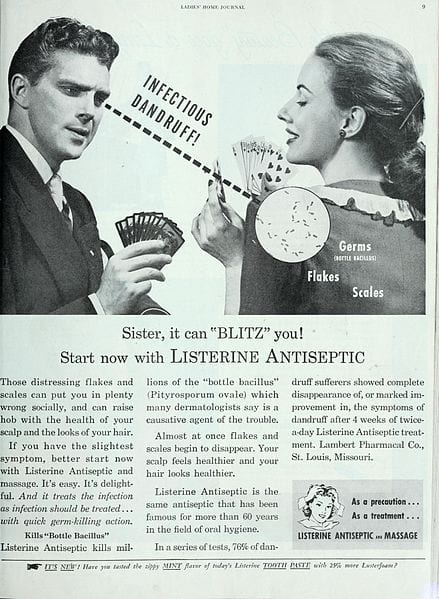
Photo Credit: Wikimedia Commons
The original formula for Listerine was created by Dr. Joseph Lawrence in 1879, and named after Joseph Lister – the pioneer of modern antiseptic surgery.
It was initially sold as a general germicide and cleansing agent, and also sold to dentists after it was found to be a highly effective sanitizer for oral wounds.
By 1914, it was popular enough to become the first over-the-counter mouthwash sold in the United States.
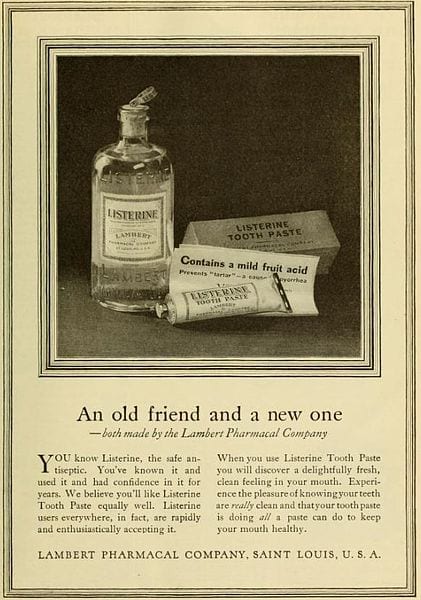
Photo Credit: Wikimedia Commons
Despite this success, the brand’s owners, Lambert Pharmacal Company felt they could boost sales even further. That’s when Jordan Lambert and his son, Gerard, came up with a brilliant and aggressive new marketing plan.
Going off the product’s already proven track record as an oral antiseptic, they decided to focus their marketing message by presenting Listerine as the solution to bad breath.
The only problem? People in those days weren’t all that concerned with bad breath and didn’t think their breath was bad enough to warrant special attention.
But the Lamberts weren’t going to give up easy, and in the early 1920s they decided to use a somewhat unique tool (for the time) to help sell more product – fear.
They took the Latin word for breath (“halitus”) and combined it with the Greek suffix for medical conditions (“-osis”) to create a new term for bad breath: “halitosis.” With this much more medical-sounding name for a common problem, they then set about preying on people’s insecurities by making them think they had a medical condition that was grossing all their friends out, but everyone was too polite to tell them.

Photo Credit: Pixabay
During this time, society was changing as more and more people were joining the workforce and moving to the city. Suddenly, people were working in close quarters with total strangers and men and women were working side by side.
Listerine capitalized on the anxiety these situations created, with a special focus on young women looking for a husband. Their ads often featured an attractive, but dejected-looking young lady who kept getting turned down by men. She’s obviously pretty, so what’s to blame for her lovelessness? The silent and all-too-common affliction of halitosis.
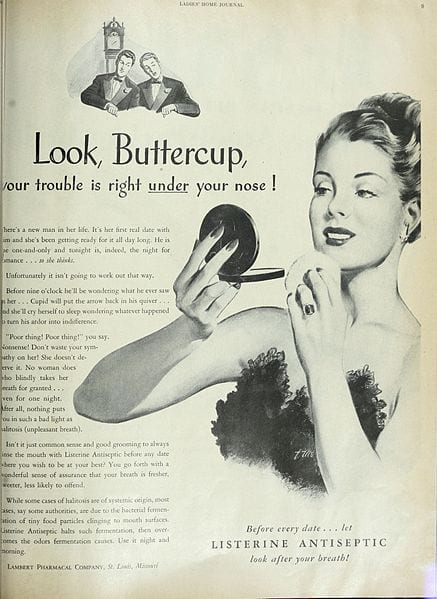
Photo Credit: Wikimedia Commons
Let’s be clear: Listerine didn’t invent bad breath itself. That’s been around since pretty much forever, and our ancient ancestors had plenty of their own recipes for ways to make your breath smell less funk-tastic.
However, bad breath wasn’t really considered a catastrophic shortcoming – it was just another part of life. Listerine changed that perception so completely, that advertising scholar James B. Twitchell once wrote that, “Listerine did not make mouthwash as much as it made halitosis.”

Photo Credit: Vintage Ad Browser
This aggressive campaign was a runaway success, and the company’s sales went from $115,000 to over $8 million in just seven short years!
Oddly enough, the company did continue to market other uses for the product as well. Most notably, they tried to sell Listerine as a remedy for colds and sore throats until 1976, when the Federal Trade Commission found these claims to be misleading and ordered them to stop.
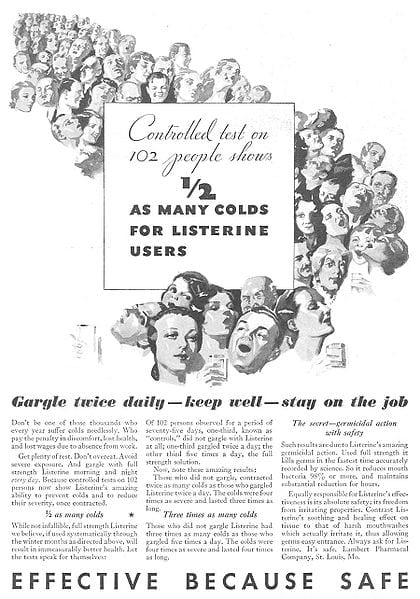
Photo Credit: Wikimedia Commons
Now, we aren’t saying that using mouthwash doesn’t help with bad breath. However, it is important to remember that most dentists agree that proper brushing and flossing are much more important when it comes to fighting plaque and maintaining overall oral health.
One of the biggest mistakes that people make is thinking that rinsing with mouthwash can make up for being negligent with the other two. Furthermore, the alcohol content in most commercial mouthwash can potentially dry out your mouth – which actually makes bad breath worse. If this happens to you, you may want to consider a non-alc*holic alternative.
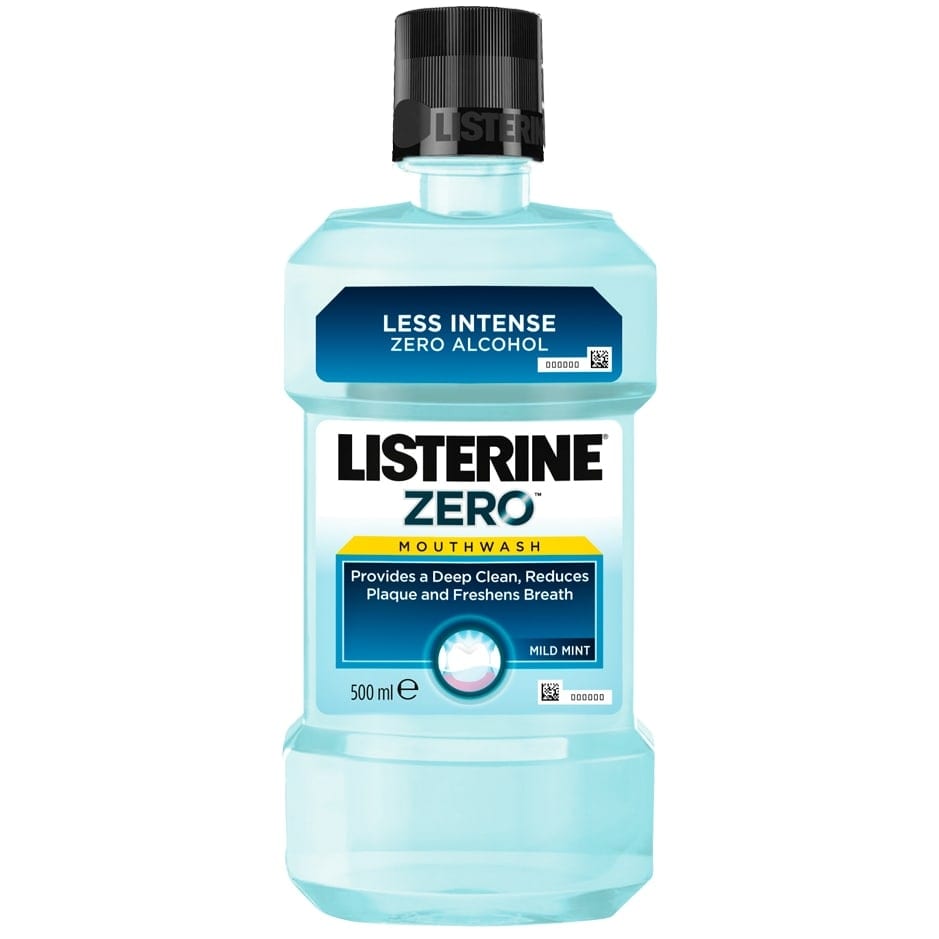
Photo Credit: Listerine
Ultimately, if you feel like using mouthwash works for you, you should keep using it.
Just know that the average person’s breath is probably fine on a daily basis (provided they’re maintaining a regular brushing and flossing routine). Mouthwash is just a nice bit of extra insurance!






